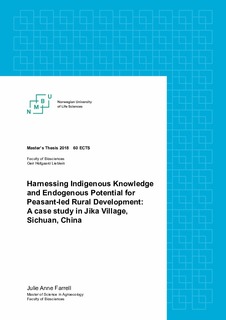| dc.contributor.advisor | Lieblein, Geir Hofgaard | |
| dc.contributor.advisor | Francis, Charles | |
| dc.contributor.author | Farrell, Julie Anne | |
| dc.coverage.spatial | China, Sichuan | nb_NO |
| dc.date.accessioned | 2018-11-20T15:11:43Z | |
| dc.date.available | 2018-11-20T15:11:43Z | |
| dc.date.issued | 2018 | |
| dc.identifier.uri | http://hdl.handle.net/11250/2574029 | |
| dc.description.abstract | In an economy where the chasm between rural and urban life widens further each day, many Chinese farmers still struggle to maintain ecologically sound farming systems that can also support socially and financially robust livelihoods. Shrinking farm sizes, rural-to-urban migration, and generally low profits from agricultural product sales shape the rural landscape. While governmental initiatives aimed at developing rural infrastructure, protecting vulnerable ecosystems, and/or alleviating financial burdens on farmers do exist, many have been shown to further marginalize China’s most vulnerable communities. As a result, existing strategies emphasize rural-to-urban migration and relocation as the inevitable solution to these complex problems. This case study from Jika Village, Danba County, Sichuan, examines how residents of a remote mountain community are mobilizing endogenous physical and knowledge-based resources to help reach self-identified development goals. The theory of endogenous development is used to assess various processes of change. The study considers aspects of rural experience often neglected in development discourse by documenting the motivations that catalyze the local community’s desire for action. It also describes various mechanisms identified as integral to carrying out development efforts, including: 1) the construction of collective confidence and ethnic identity; 2) organized systems for decision-making and record keeping; 3) empowerment of women; 4) inclusion of multiple generations in development processes; and 5) support of extra-village partners. In doing so, the case study contributes to a discussion of bottom-up development that has been largely restricted to Western locales. | nb_NO |
| dc.language.iso | eng | nb_NO |
| dc.publisher | Norwegian University of Life Sciences, Ås | nb_NO |
| dc.rights | Attribution-NonCommercial-NoDerivatives 4.0 Internasjonal | * |
| dc.rights.uri | http://creativecommons.org/licenses/by-nc-nd/4.0/deed.no | * |
| dc.subject | Agroecology | nb_NO |
| dc.subject | Endogenous Development | nb_NO |
| dc.subject | Participatory action research | nb_NO |
| dc.title | Harnessing indigenous knowledge and endogenous potential for peasant-led rural development : a case study in Jika village, Sichuan, China | nb_NO |
| dc.type | Master thesis | nb_NO |
| dc.subject.nsi | VDP::Social science: 200::Urbanism and physical planning: 230::Spatial, territorial planning: 238 | nb_NO |
| dc.subject.nsi | VDP::Social science: 200 | nb_NO |
| dc.subject.nsi | VDP::Agriculture and fishery disciplines: 900 | nb_NO |
| dc.description.localcode | M-AE | nb_NO |

